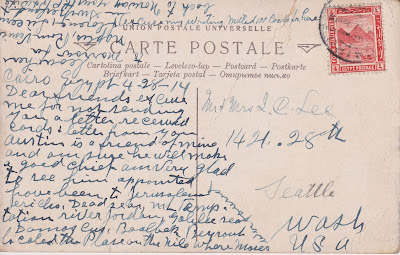EGYPT -- The Pyramids of Gizeh Showing Overflow of River Nile -- LL, 1914
As mentioned in several previous postcard Thursdays, I.C. & Petra Lee had many friends who traveled widely and sent postcards to them. The above card is a scene from along the Nile River with the famous Gizeh (Giza) pyramids in the background. The French printer and photograph editing company Léon & Lévy (LL) founded in 1864 issued it. This company was located in Paris and specialized in stereoscopic views of European, Asian, African and American scenes. Stereoscopic cards had two images and required a reading device to produce a 3-D effect unlike this card that has only one image. LL was one of the most important editors of postcards in France. The trademark LL can be seen following the title of the card at the upper left. Like many other postcard publishers of that time LL numbered their editions, this one is 17. The original photograph was a black & white that was colored or tinted before mass-producing as a postcard.
Message on the reverse
“Cairo, Egypt 4-28-14 Dearest friends excuse me for not sending you a letter. Received cards & letter from you. Austin is a friend of mine and [I] am sure he will make a good chief. Am very glad to see him appointed. Have been to Jerusalem, Jericho, Dead Sea, Mt. Temptation, River Jordan, Galilee sea, Damascus, Baalbek [in Lebanon], Beyrout [Beirut], located the place on the Nile where Moses was found. Leave here tomorrow for Naples, Rome, Venice, Florence, Lucerne in Switzerland & back to Norway. Your, H.P. R. & wife. Excuse my writing, mailed 100 cards from here.”
The Austin mentioned in the note was Austin E. Griffiths (1863-1952) who was Seattle Chief of Police from 1914 to 1915 and later went on to become a Superior Court Judge. I.C. Lee was a Sergeant in the Seattle Police Force from 1905 until his death in 1930.
Tourism in Egypt increased following the discovery of King Tut’s tomb in 1922 but even before then when this card was mailed in 1914 the pyramids were a fascination for travelers. The postcard picture shows the three largest pyramids at Giza and two of the smaller ones found there. The pyramids shown are counted among the largest structures ever built and the Great Pyramid of Khufu is the only one of the Seven Wonders of the World still in existence today. It is generally agreed that they were burial monuments but there is some disagreement concerning the theological principals involved. The shape is thought to represent the descending rays of the sun and the outside was faced with white limestone that gave the pyramids a brilliant appearance from a distance. Most of the limestone facing has eroded away and only a small amount remains at the pinnacle of the Great Pyramid. All the pyramids were built on the west bank of the Nile and received the setting sunlight associated with the realm of the dead in Egypt. Some pyramids were buried or covered with sand and “lost” so the number first discovered in 1842 (67) had grown to 118 by 2008. Work is still being conducted and perhaps more discoveries will come to light in the future.
Not all of the pyramids are open to the public and those that are open are not all open at the same time. When the King Tut exhibit was here in Seattle at the Pacific Science Center a few years ago a series of rooms were recreated to show what Howard Carter found when Tut’s tomb was opened in 1922. It was rather amazing to find this postcard and realize these visitors were there when Egypt was a British Sultanate (1914-1922) and saw the pyramids before the discovery of King Tut.
World War I began in Europe in July 1914 and this card was posted in April of that year. With the list of places still to visit this couple must have just barely returned home before the war began. Although this is not a photo of a historically significant event or person it does fall into the category of a historical postcard simply by virtue of where it came from and the proximity to the beginning of the war.
A 1914 Egypt 4 milliemes stamp
For additional information, see:
https://en.wikipedia.org/wiki/Cairo
https://en.wikipedia.org/wiki/Sultanate_of_Egypt
https://en.wikipedia.org/wiki/Valley_of_the_Kings
http://discoveringegypt.com/pyramids-temples-of-egypt/pyramids-of-giza/
https://en.wikipedia.org/wiki/Great_Pyramid_of_Giza
https://en.wikipedia.org/wiki/Egyptian_pyramids
https://en.wikipedia.org/wiki/L%C3%A9on_%26_L%C3%A9vy



No comments:
Post a Comment